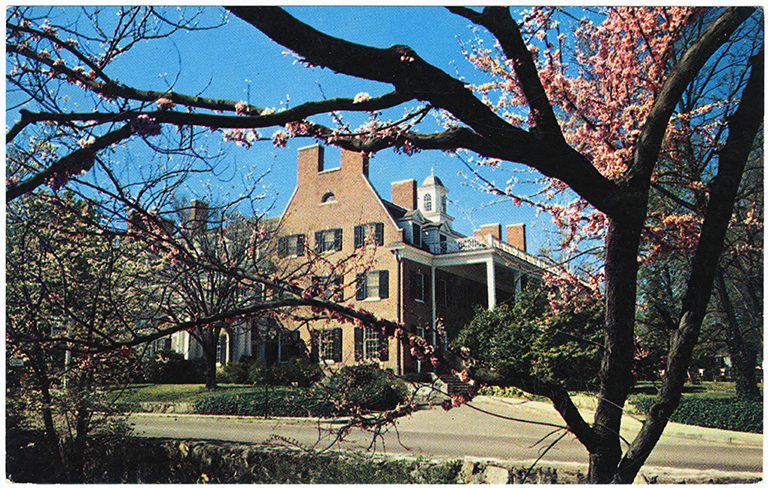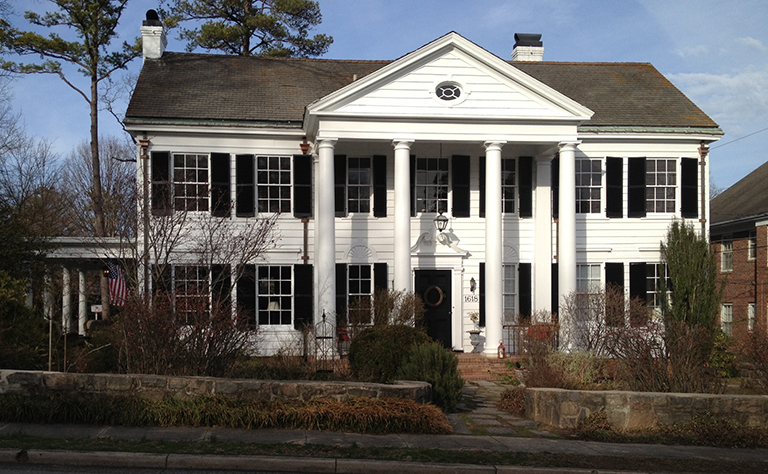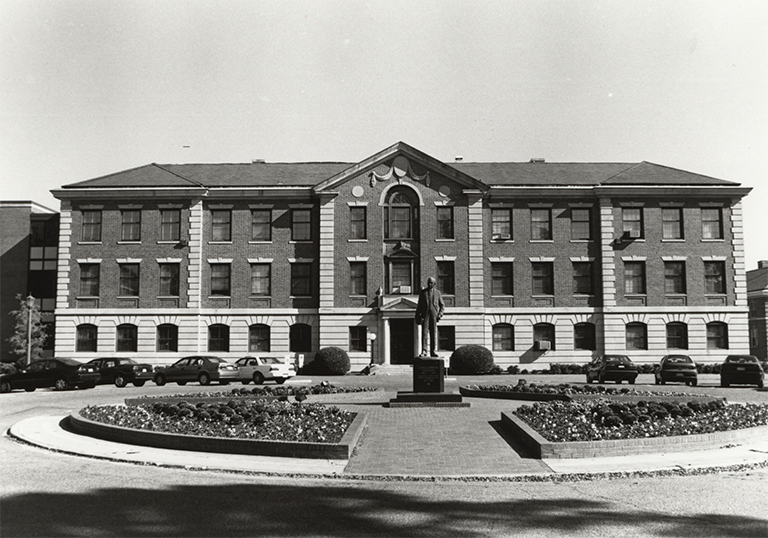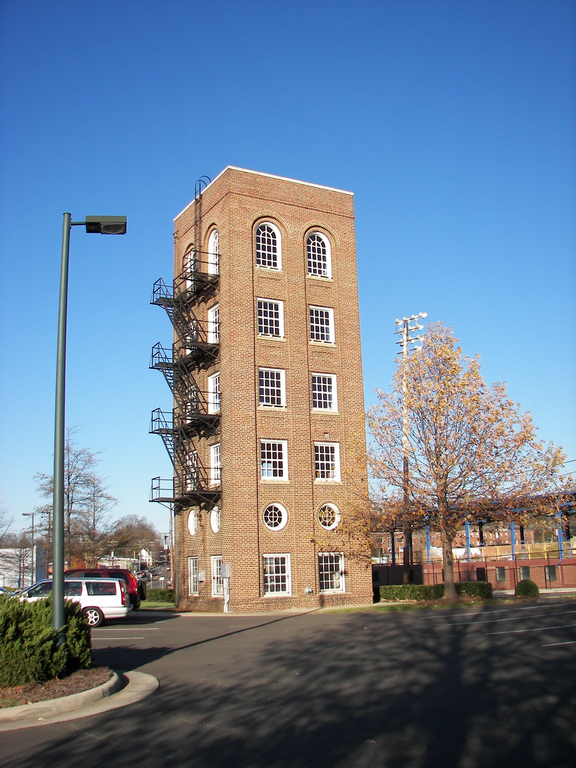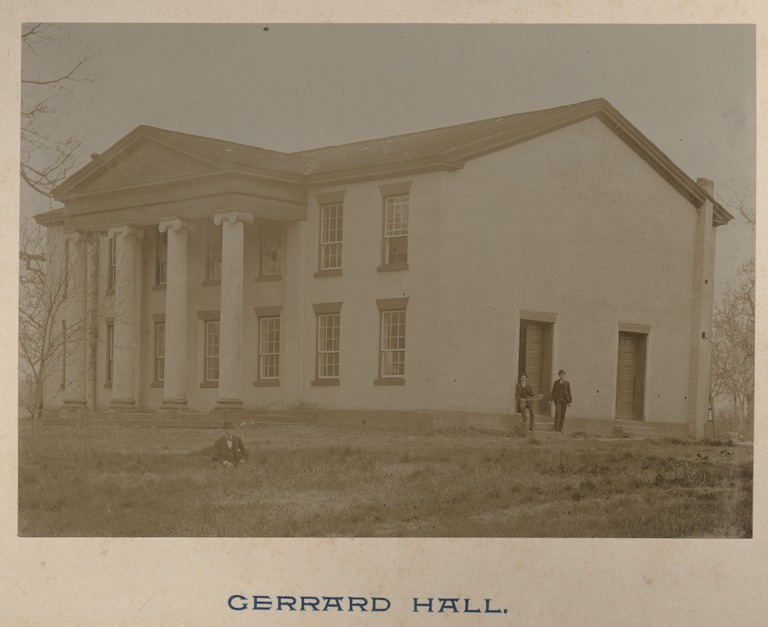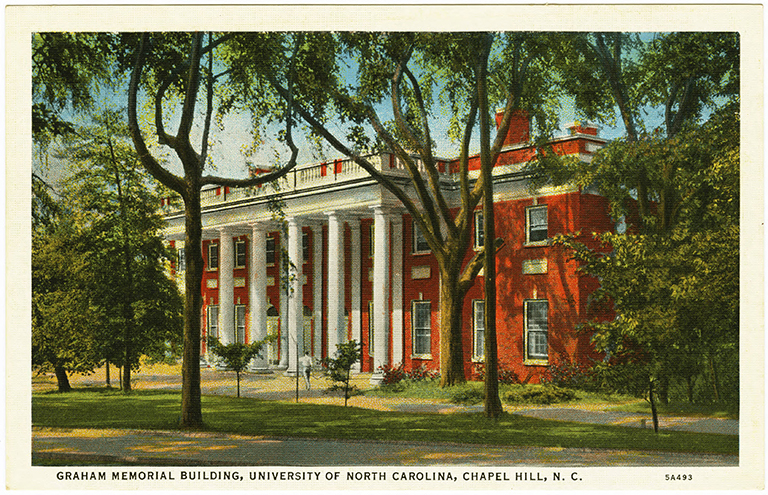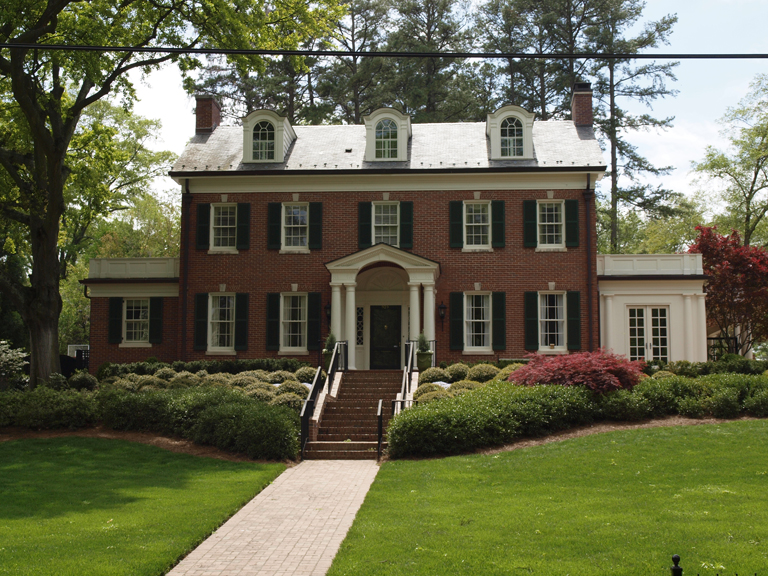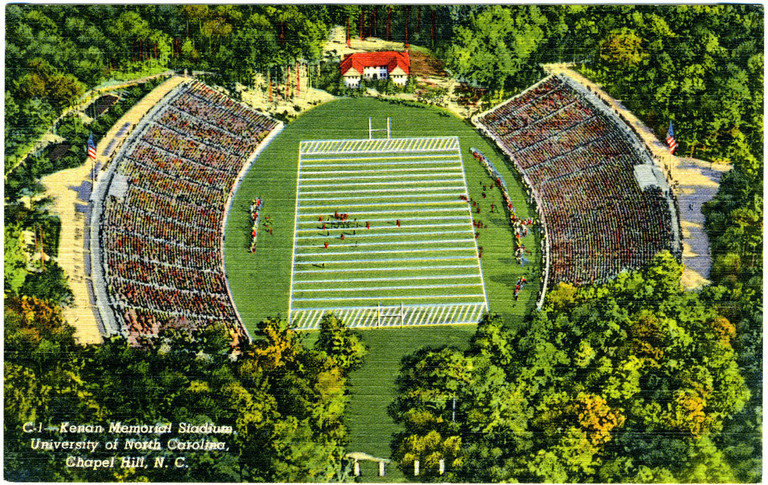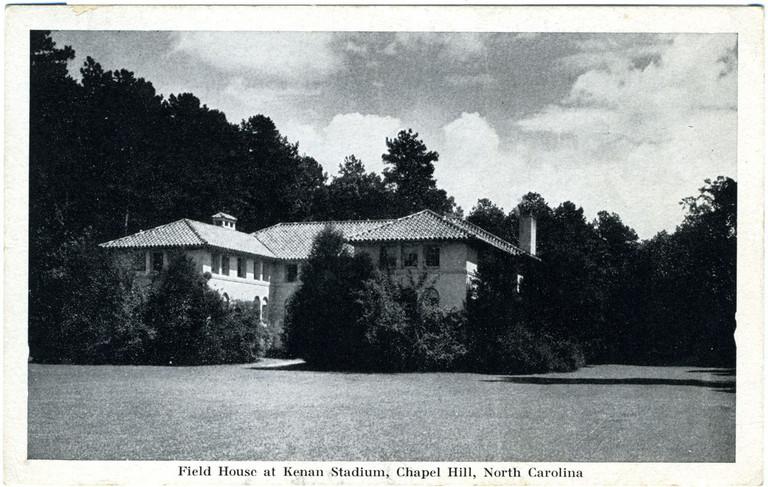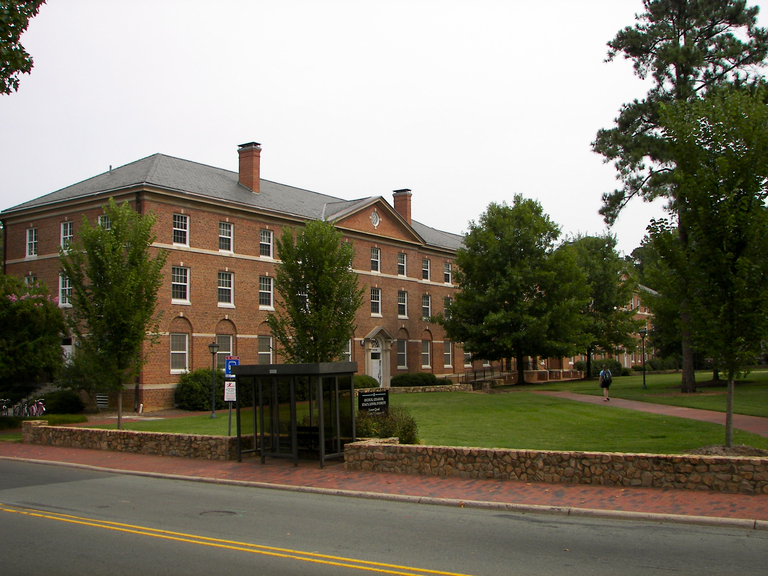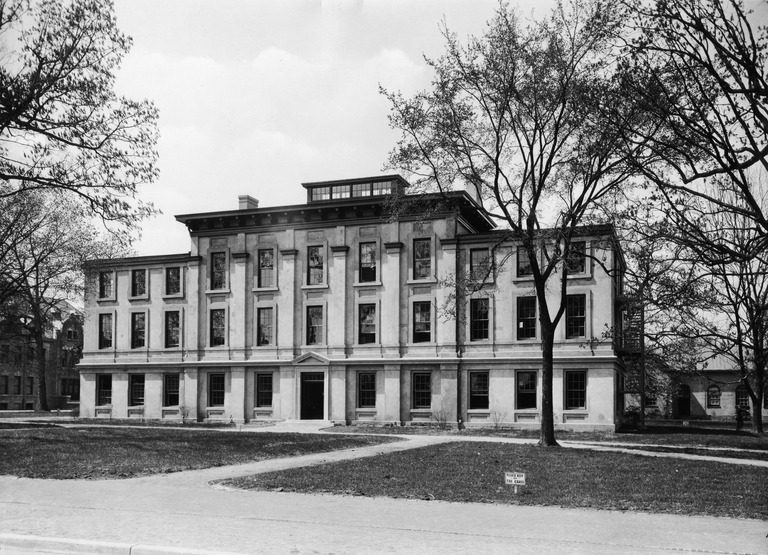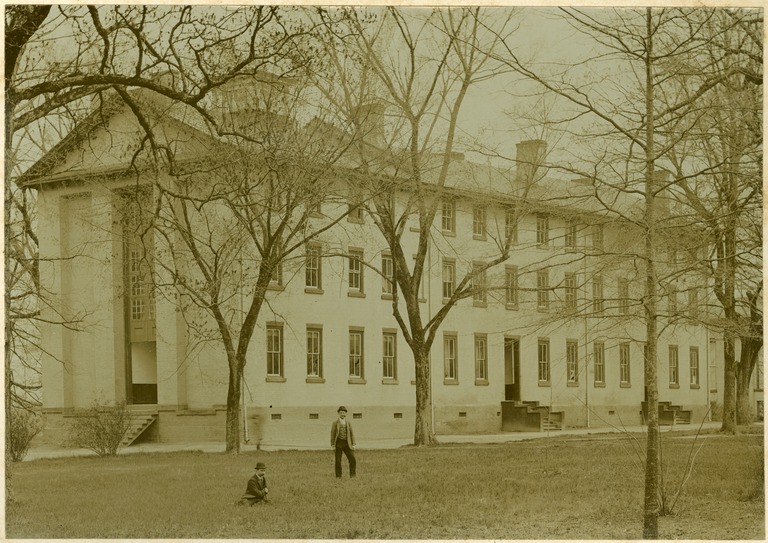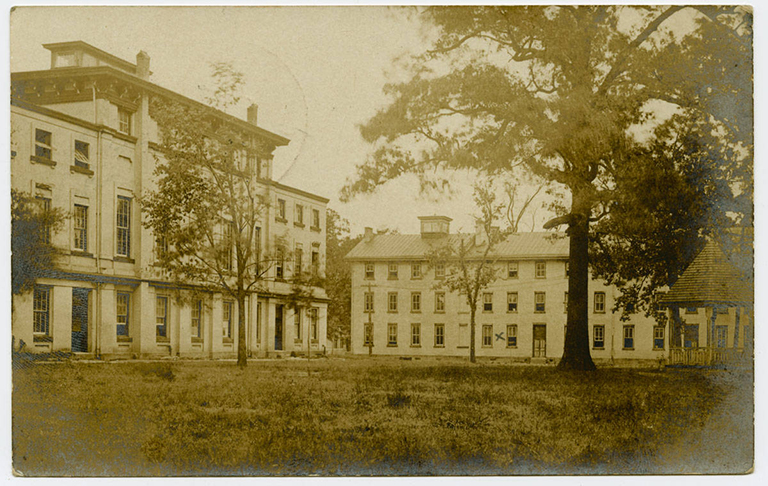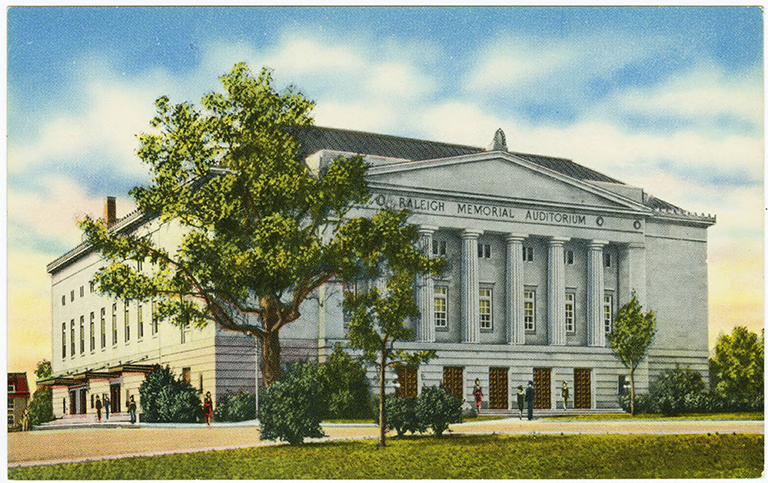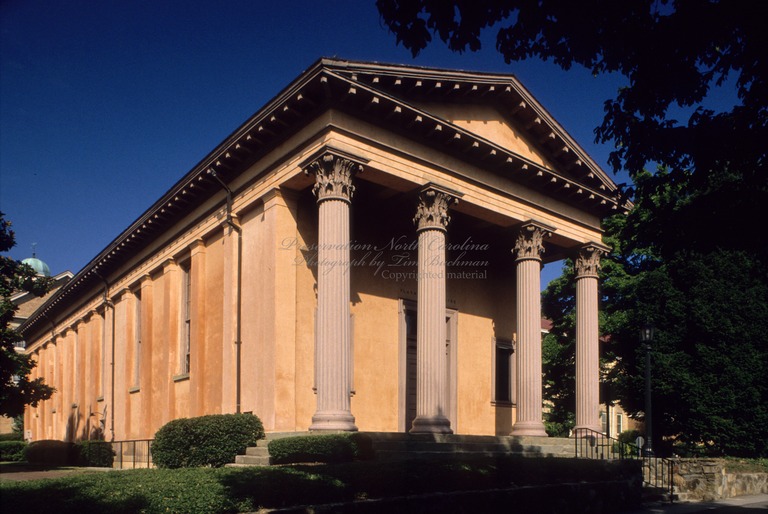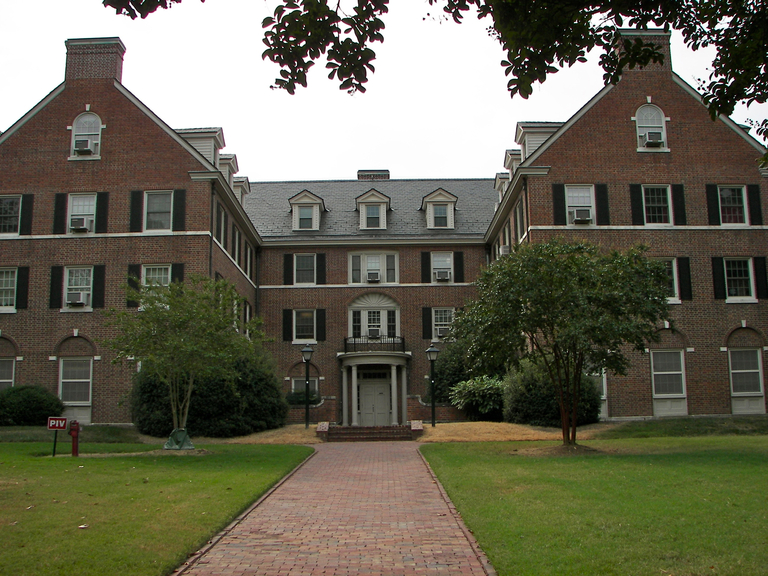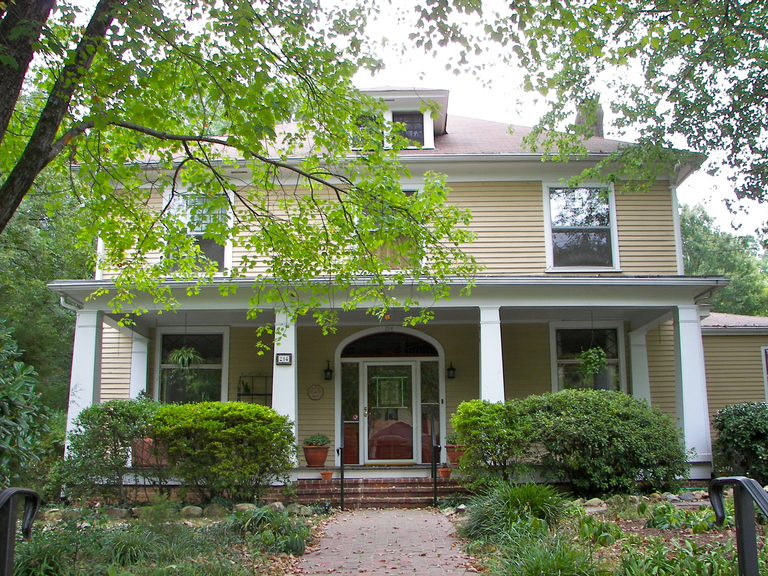Nash, Arthur C. (1871-1969)
Variant Name(s):
Arthur Cleveland Nash
Birthplace:
Geneva, New York, USA
Residences:
- New York City, New York
- Chapel Hill, North Carolina
- Washington, D.C.
- Baltimore, Maryland
Trades:
- Architect
Building Types:
Styles & Forms:
Beaux-Arts; Colonial Revival; Georgian Revival; Neoclassical Revival; Spanish Colonial Revival
Arthur Cleveland Nash (October 21, 1871-September 26, 1969), a Beaux-Arts trained New York architect, designed many buildings in North Carolina and is best known as campus architect for the University of North Carolina at Chapel Hill during the school’s major expansion in the 1920s. There he worked in association with the consulting firm of McKim, Mead and White and engineer Thomas C. Atwood, with whom he formed Atwood and Nash, Architects and Engineers (see Atwood and Nash). Among Nash’s major works were the Beaux-Arts Louis Round Wilson Library, with William Kendall of McKim, Mead and White, and the Georgian Revival Carolina Inn. He did much to establish the “colonial” mode as the predominant style for the campus and for Chapel Hill, setting a precedent that was followed well into the 1950s and readapted after a lapse.
Arthur Nash was born in Geneva, New York, the son of Francis Philip Nash, Professor of Romance Languages at Hobart College and Katharine Cleveland Coxe Nash, daughter of the Right Reverend Arthur Cleveland Coxe, Episcopal Bishop of Western New York. After attending Philips Exeter Academy, Nash graduated from Harvard, class of 1894. He spent a year at Massachusetts Institute of Technology and then left for Paris and the Beaux Arts Institute. Here for five years he studied in the atelier of Jean Louis Pascal. He received medals in architecture, archaeology, and modeling and was awarded a diploma in 1900. Returning to the United States he taught briefly at Cornell University in the School of Architecture and then moved to New York City to practice architecture. There he designed houses in New York and New Jersey and a clubhouse in Greenwich, Connecticut, and began his collegiate work with a gymnasium and science building for Hobart College and a dormitory for Smith College.
In 1922 his work began for North Carolina. He later told the story that one day when he was walking down Fifth Avenue he encountered William M. Kendall, a principal of the New York firm of McKim, Mead and White, which had recently taken a large commission to expand the University of North Carolina in Chapel Hill. Kendall said that the firm needed to send an architect to serve on site and asked Nash if he was interested. Nash promptly accepted. He and his family moved to Chapel Hill, where he spent the rest of the decade as building architect for the university in association with engineer Atwood, with Kendall representing the consulting firm of McKim, Mead and White and visiting the campus at intervals.
Nash found in Chapel Hill a small but rapidly growing university with classically detailed and Italianate style buildings dominating the original campus, which focused on the old quadrangle now known as McCorkle Place, stretching from Franklin Street and the village of Chapel Hill on the north to Cameron Avenue on the south.
Planning and construction for the expansion of the campus had already begun. Urban planner John Nolen had been hired in 1913 to help develop a master plan for the university. Between l917 and 1919 he analyzed the campus and suggested development of land to the south with a plan centered on a second, southern quad. Execution of his ideas was delayed by World War I and by the death of university president Edward Kidder Graham in the influenza epidemic of 1918. After the war with a jump in enrollment, a successful state bond issue, and the leadership of the new president, Harry Chase, work got underway. A “Trustees’ Building Committee” of powerful alumni and state leaders played an important role throughout the long and complex project, with banker and university benefactor John Sprunt Hill of Durham as chair from 1924 to 1931. Another important contributor to the building program was the Faculty Committee on Grounds and Buildings, chaired by Professer William C. Coker. An initial building in the new quadrangle, Steele Hall, a Federal Revival dormitory, was completed in 1920 from designs by Raleigh architect James A. Salter.
As noted by Charlotte V. Brown in Architects and Builders in North Carolina, university leaders considered several nationally prominent architectural firms before choosing McKim, Mead and White in 1920. The university had also obtained recommendations from Aberthaw, an Atlanta engineering and campus planning firm, which suggested the placement of classroom buildings near the center of the campus expansion and dormitories at the periphery, types of plans for dorms, and the general red brick “colonial” style as well suited to North Carolina. McKim, Mead and White and the committee developed Nolen’s plan and Aberthaw’s suggestions still further.
To handle the large and complex project the university established in 1921 a professional engineering and architectural team in residence, headed by Thomas C. Atwood, an experienced New England engineer known for his ability to carry through large projects. Atwood, recognized nationally for the immense stadium known as the Yale Bowl, was in North Carolina as engineer for an expansion of the Durham Hosiery Mills before being employed by the university as “executive agent” of the building committee who was to “develop his own organization and . . . administer the whole work.” The “T. C. Atwood Organization” included additional engineers, draftsmen, and an architect—initially H. P. Alan Montgomery who was succeeded by Nash in April, 1922. Atwood’s organization worked under the guidance of the university committee and McKim, Mead and White. The general contract for the immense project went to T. C. Thompson of Charlotte.
By the time Nash arrived in 1922, several buildings were already underway. The South Quad (known today as Polk Place) had been begun as the focal point of the South Campus, and the red brick Georgian Revival style was well established. H.P. Alan Montgomery, Nash’s predecessor as building architect, had designed several Georgian Revival buildings including classroom buildings (Manning, Saunders, and Murphey) defining the eastern side and cross-axis of Polk Place. (The western cross-axis has a similar ensemble designed by Nash’s successor Weeks in the 1950s.)
Among the first campus buildings for which Nash served as architect were Bingham Hall at the southeast corner of the South quadrangle and Venable Hall. Beyond the main South Quad, as suggested by Aberthaw’s study, were dormitory quadrangles known as the upper and lower quads, which continued the established style. Montgomery had previously designed Ruffin, Mangum, Manly, and Grimes Halls (1921) in the Upper Quad, and Nash planned Aycock, Graham, Lewis, and Everett Halls (1924-1933) in the Lower Quad (see Lower Quad Dormitories). All have a sense of open space between them and a well-proportioned layout. Nash also designed Spencer Hall (1924), the first women’s dormitory, in the form of a large and imposing Georgian Revival house, on a large lot facing Franklin Street.
In the late 1920s, Nash focused special attention on the two edifices that defined the ends of Polk Place. South Building at the southern end of McCorkle Place, was an austere brick building built between 1798 and 1814 at the ridgeline that divides the north and south campuses. President Edwin Alderman had enriched it on the north front with a doorway copied from Westover in Virginia, as well as adding a temple cover to the Old Well in front of it. Beginning in 1926, Nash rebuilt the interior from the ground through the roof and changed the roofline, but his major contribution to South Building was a portico of four Ionic columns added to the south face of the building in 1927, creating an imposing façade that dominates the north end of Polk Place.
At the other end is the Louis Round Wilson Library, the “crowning glory” of the building campaign, with its six-columned Corinthian portico and great round dome. Reports of the time stated that the library was designed by Atwood and Nash, with the McKim firm consulting, and it was indeed a collaborative work. The idea of the dome and the detailing on this building are generally credited to Kendall of McKim, Mead and White: the firm had designed the much-acclaimed Low Library at Columbia University with its great dome, and at Carolina the dome was repeated. The overall design, especially the layout, was the work of Nash. Nash gave credit for the building to Kendall, especially for the detailing, but drawings by Nash (see John V. Allcott, The Campus at Chapel Hill: Two Hundred Years of Architecture (1986), p. 70) indicate his role as well. The limestone exterior contrasts effectively with the surrounding red brick buildings. On the interior is a series of elegant spaces with beautiful detailing—reading and reference rooms, an ornamental stairway, all well lit and beautifully furnished. When completed in 1929 the library was acclaimed the most beautiful building on campus and perhaps in North Carolina.
Beyond the south quadrangle, Nash designed the Kenan Stadium and Kenan Stadium Field House to the east of it in 1927. The stadium designed in Greek style had seats on the hillsides on either side of a creek (which flows beneath the field) in a park like setting, while the field house at the end of the field was in a contrasting Spanish Colonial style with a colorful red tile roof. (In recent years the stadium has been much enlarged and changed and the field house has been razed.) Nash also added buildings to the older part of the campus. Facing McCorkle Place Nash designed Graham Memorial Building (1929-1931) as a student center erected in memory of president Edward Kidder Graham. In 1930 he developed a proposal (see Allcott, Campus, p. 73) to provide a formal approach to the northern end of the campus. The envisioned Georgian Revival structures would have faced Franklin Street with a new Memorial Hall in the center; the Graham building on the left (east), and another similarly designed building to replace Frank Pierce Milburn’s Battle-Vance-Pettigrew Hall on the right. The stock market crash and the Great Depression halted these plans, and only the Graham Building came to fruition: it lacked Nash’s projected wings. Nash’s Memorial Hall, a Beaux-Arts classical composition with front colonnade, was erected west of South Building on the Cameron Street site of its predecessor, the massive and eccentric Victorian edifice designed by Samuel Sloan.
Nash also extensively renovated several of the older buildings on and near McCorkle Place, including the two oldest buildings on campus, Old East (1793-1795, James Patterson, Alexander Jackson Davis) and Person Hall (1795-1798), as well as William Nichols’s Gerrard Hall (1822). He also worked on Old West, New East and New West and planned the 1930 conversion of Frank Pierce Milburn’s Carnegie Library into Hill Hall as the Music Building with auditorium added. One of the most interesting buildings on campus is the Playmakers Theater, originally known as Smith Hall. Designed by Alexander Jackson Davis, the temple-form structure was built in 1850 as a ballroom, which the students wanted, with shelves added to make it a library, which pleased the faculty. Under Nash the neoclassical structure became in 1924-1925 a theater for the university’s emerging Playmakers group. (See Powell, First State University, p.177, for the interior remade into a theater.) As a result of these “renovations,” all that is original of the pre-1860 campus buildings (except Smith Hall) is the brick walls.
Nash’s commissions in North Carolina extended beyond the university. By 1923 he and Atwood had formed a partnership called Atwood and Nash, Inc., Architects and Engineers, with offices in Durham and Chapel Hill. (Atwood later partnered with H. Raymond Weeks as Atwood and Weeks, and in some cases there is ambiguity over which firm was responsible for specific projects, especially those that continued over several years.)
Nash had an especially strong influence on the growing community of Chapel Hill. A community landmark, the Carolina Inn, built in 1923-1924 adjoining the campus, has been extensively renovated and enlarged over the years but the fundamental design remains Nash’s. It was conceived and sponsored by John Sprunt Hill, an alumnus and major benefactor of the university. After financing the structure, in 1935 Hill donated it to the university. The dedicatory plaque reads “This generous gift affords a cheerful inn for visitors, a town hall for the state, and a home for returning sons and daughters of alma mater.” Nash’s design brought to fruition Hill’s dream of an inn that resembled Mount Vernon with its long portico, cupola, and roof balustrade. The inn continues to serve as a meeting place and hostelry for friends of the university and was dubbed by former university president William Friday “the University’s Living Room.”
Also in Chapel Hill, Nash is credited with the design of some of the fraternity houses built immediately west of campus, something of a new building type in the 1920s, which he planned as oversized Georgian Revival residences in red brick with large or small porticoes. Subsequent fraternity houses in the area followed Nash’s precedent. Nash also advocated the red brick “colonial” style for Chapel Hill’s commercial district along Franklin Street, as having the “dignity, repose and cultivation” appropriate to a scholarly town, and many merchants incorporated the style as translated into a “Williamsburg” mode into their store fronts. He also designed several private residences in town including his own home, the Nash-Wallach-Kalo House at 124 S. Boundary Street. When Chapel Hill resident Cornelia Spencer Love developed her own plans for her residence on Laurel Hill Road, she wanted to have her plan approved by Atwood and Nash; she later recalled that a draftsman for the firm made the blueprints for her and “Mr. Nash himself added curving tips to the roof and a small porch which greatly improved the appearance.”
In Durham, just a few miles from Chapel Hill, Nash planned several public and private edifices in a variety of revival styles. For the Durham Fire Training Tower, where firemen practiced their firefighting techniques, he created a carefully proportioned structure akin to Giotto’s tower in Florence: though without the sculptural decoration or varied colored marble, it features the paired openings of Giotto’s tower, and the circular windows copy those of the Florentine cathedral next to the tower. At Watts Hospital ( begun in 1908 by Kendall and Taylor of Boston), the Valinda Beale Watts Pavilion added by Atwood and Nash in 1926 followed the facility’s established Spanish Mission style with Renaissance detailing. For Durham’s Old Hill Building (1925), Atwood and Nash employed a restrained Renaissance mode, with arched windows rising through the upper three stories and cartouches with John Sprunt Hill’s monogram.
In their largest project in Durham, Atwood and Nash employed their traditional red brick Georgian Revival style when they were commissioned to design a new campus ensemble for present North Carolina Central University, which was growing rapidly under the leadership of President James E. Shepard. In 1925 the private school established in 1909 became the state-supported North Carolina College, the nation’s first state-supported liberal arts college for black students. Funds from the state and from Durham philanthropist Benjamin N. Duke supported a major building campaign. Completed by 1930 were the formal, classically detailed Clyde R. Hoey Administration Building, the Alexander Dunn Hall, and Annie Day Shepard Hall. Subsequent buildings erected with New Deal funding continued the vocabulary established by Atwood and Nash. The firm also planned a number of public schools in and near Durham.
In Raleigh, the firm gained several prominent commissions, and here too they followed Beaux-Arts principles, employing a variety of revival styles to suit different situations and to harmonize with the setting. For the Revenue Building facing the State Capitol, they continued the capitol square’s established vocabulary of restrained Beaux-Arts classicism rendered in pale gray stone to complement the 1840 Greek Revival capitol. In new buildings at Peace College, the firm used the red brick Georgian Revival mode to harmonize with the antebellum main building by Thomas J. Holt and Jacob W. Holt. Atwood and Nash also planned renovations and restoration work at such Raleigh landmarks as the North Carolina State Capitol and the Executive Mansion. Nash designed a number of houses in Raleigh, primarily in Georgian Revival style. Notable among these is the stately red brick Jolly-Broughton House (1928) built for Mrs. Frank Jolly in the Hayes Barton suburb and later the home of Governor J. Melville Broughton. For Episcopal bishop Joseph B. Cheshire he designed the white frame Cheshire House with a tall portico, located in the Cameron Park neighborhood.
A departure from sober classicism came with the festive and eclectic design for the State Fair, an institution newly relocated on a site west of Raleigh. In the State Fairgrounds Exhibition Buildings Atwood and Nash presented a lively combination of Spanish and Moorish motifs, so that when the new fairgrounds opened in 1928, fairgoers entered through paired gates flanked by towers, piers, and twisted columns. Red tile roofs and stuccoed walls completed the ensemble.
Beyond the Piedmont, as noted in the Asheville Citizen of October 22, 1929, Atwood and Nash opened an office in the booming mountain town of Asheville, with architect Lindsey M. Gudger as local manager; Asheville was soon hit hard by the Crash, however, and the office closed. A key work in the city was the lavish Tudor Revival style John Sprunt Hill House in the Biltmore Forest suburban village developed near Asheville on a portion of the Biltmore estate. At the other end of the state, Nash employed the Neoclassical Revival mode for the Alexander Sprunt House (1929-1930), built in Wilmington for a relative of John Sprunt Hill.
In 1930 Nash retired and moved to Washington, D. C., but he continued until 1953 as consulting architect to H. Raymond Weeks, who became the university architect at Chapel Hill, and in that role contributed design ideas for a such later university buildings as the public health and medical building, Woolen Gymnasium, Bowman Gray Swimming Pool, and Lenoir Hall. He also helped plan several new dormitories—Alderman, Stacy, McIver and Whitehead—as well as working on Wilson Hall and the women’s gymnasium. With local architect Archie Davis he served as consultant for the naval armory and Navy Hall (later the Monogram Club). He also served as consultant for portions of the North Carolina Memorial Hospital complex and additions to the Carolina Inn, Wilson Library and Venable Hall. Meanwhile, Thomas C. Atwood had formed a partnership with architect Weeks, known as Atwood and Weeks, which moved to Durham in 1931 and planned many major buildings in the state.
The North Carolina Chapter of the American Institute of Architects wanted to nominate Nash for consideration as a Fellow, especially for his work on Wilson Library, but Nash turned down the honor. He felt that others also deserved credit for his work, citing as an example William Kendall, chief representative of McKim, Mead and White, who Nash said had done much of the detailing of the library. At the June 1954 commencement in Chapel Hill, Nash was awarded an honorary Doctor of Laws degree.
At Grace Episcopal Church in New York on August 12, 1914, Nash married Mary Screven Arnold, a distinguished portrait painter. They were parents of a daughter Katharine Cleveland who married Edward E. Caldwell. Nash died at the Caldwell home in Baltimore and was buried in Mount Auburn Cemetery, Cambridge, Massachusetts.
Note: The building list includes Nash’s best-known works but not all of the many residences and other structures he designed. Further research will identify more of these. Renovations and restorations and consulting projects are cited in the text but do not have separate building entries unless they are included in building lists for the architects of record such as H. Raymond Weeks. For a more extensive listing of projects by Atwood and Nash and Atwood and Weeks, see Atwood’s “Cubic Foot Costs Book,” Special Collections Research Center, NCSU Libraries, Raleigh, North Carolina.
- John V. Allcott, The Campus at Chapel Hill: Two Hundred Years of Architecture (1986).
- Thomas C. Atwood, “Cubic Foot Costs Book,” Special Collections Research Center, North Carolina State University Libraries, Raleigh, North Carolina.
- Catherine W. Bishir, Charlotte V. Brown, Carl R. Lounsbury, and Ernest H. Wood III, Architects and Builders in North Carolina: A History of the Practice of Building (1990).
- Catherine W. Bishir and Michael T. Southern, A Guide to the Historic Architecture of Piedmont North Carolina (2003).
- Martha B. Caldwell, “Arthur Cleveland Nash,” in William S. Powell, ed., Dictionary of North Carolina Biography, 4 (1991).
- Martha B. Caldwell, personal conversations with Katharine Nash Caldwell, Chapel Hill, early 1990s.
- Martha B. Caldwell, personal conversations with Arthur C. Nash, Baltimore, Maryland, late 1950s.
- Archibald Henderson, The Campus of the First State University (1949).
- M. Ruth Little, The Town and Gown Architecture of Chapel Hill, North Carolina, 1795-1975 (2006).
- Cornelia Spencer Love, When Chapel Hill Was a Village (1976).
- Arthur C. Nash Papers, Southern Historical Collection, Wilson Library, University of North Carolina at Chapel Hill, Chapel Hill, North Carolina.
- William S. Powell, The First State University: A Pictorial History of the University of North Carolina (1992).
- Claudia P. Roberts (Brown) and Diane E. Lea, The Durham Architectural and Historic Inventory (1982).
- William D. Snider, Light On the Hill: A History of the University of North Carolina at Chapel Hill (1992).
- Louis Round Wilson, The University of North Carolina 1900-1930 (1957).
Alexander Dormitory
Contributors:Thomas C. Atwood, engineer; Atwood and Weeks, architects; Arthur C. Nash, consulting architect; H. Raymond Weeks, architectDates:1939
Location:Chapel Hill, Orange CountyStreet Address:University of North Carolina at Chapel Hill, Chapel Hill, NC
Status:Standing
Type:Educational
Alexander Dunn Hall
Contributors:Dates:1930
Location:Durham, Durham CountyStreet Address:North Carolina Central University Campus, Lawson St., Durham, NC
Status:Standing
Type:Educational
Images Published In:Claudia P. Roberts (Brown) and Diane E. Lea, The Durham Architectural and Historic Inventory (1982).
Alexander Sprunt House
Contributors:Dates:1929-1930
Location:Wilmington, New Hanover CountyStreet Address:1615 Chestnut St., Wilmington, NC
Status:Standing
Type:Residential
Note:Blueprints and specifications for the Sprunt house, by Atwood and Nash and signed by both men, survive in private hands and depict the evolution of the design of the large Colonial Revival residence.
Annie Day Shepard Hall
Contributors:Dates:1930
Location:Durham, Durham CountyStreet Address:North Carolina Central University Campus, Lawson St., Durham, NC
Status:Standing
Type:Educational
Images Published In:Claudia P. Roberts (Brown) and Diane E. Lea, The Durham Architectural and Historic Inventory (1982).
Note:The building was named for the wife of college president James Shepard; she was the granddaughter of the noted Caswell County cabinetmaker Thomas Day.
Baldwin's Department Store
Contributors:Dates:1927
Location:Durham, Durham CountyStreet Address:107 W. Main St., Durham, NC
Status:Standing
Type:Commercial
Images Published In:Claudia P. Roberts (Brown) and Diane E. Lea, The Durham Architectural and Historic Inventory (1982).
Bingham Hall
Contributors:Thomas C. Atwood, engineer; William M. Kendall, consulting architect; McKim, Mead and White, consulting architects; Arthur C. Nash, architect; T. C. Thompson, contractorsDates:1920s
Location:Chapel Hill, Orange CountyStreet Address:University of North Carolina Campus, Chapel Hill, NC
Status:Standing
Type:Educational
Images Published In:M. Ruth Little, The Town and Gown Architecture of Chapel Hill, North Carolina, 1795-1975 (2006).
Note:Bingham Hall, which completed the east side of the South Quad, was initially designed by H. Alan Montgomery but was built a few years later with Arthur C. Nash as building architect. It anchors the southeastern corner of the quad.
Bullitt House
Contributors:Arthur C. Nash, architectDates:1922
Location:Chapel Hill, Orange CountyStreet Address:411 E. Rosemary St., Chapel Hill, NC
Status:Standing
Type:Residential
Carolina Inn
Contributors:Dates:1923-1924
Location:Chapel Hill, Orange CountyStreet Address:Corner of Cameron St. and Columbia St., Chapel Hill, NC
Status:Altered
Type:Commercial
Images Published In:M. Ruth Little, The Town and Gown Architecture of Chapel Hill, North Carolina, 1795-1975 (2006).
William S. Powell, The First State University: A Pictorial History of the University of North Carolina (1992).
Cheshire House
Contributors:Atwood and Nash, architects (ca. 1924); Thomas C. Atwood, engineer (ca. 1924); Arthur C. Nash, architect (ca. 1924); Howard E. Satterfield, builder (late 1910s)Variant Name(s):Bishop Joseph B. Cheshire House
Dates:late 1910s; ca. 1924
Location:Raleigh, Wake CountyStreet Address:1618 Ambleside Dr., Raleigh, NC
Status:Standing
Type:Residential
Note:Attorney Joseph B. Cheshire, Jr., son of the Episcopal bishop of the same name, appeared in the city directory of 1917 as residing on Hawthorne Road, and from 1918 onward had the address of 1618 Ambleside. (The property is located at the corner of the two streets.) It is believed that Satterfield built a moderate sized house for Cheshire at first, and then expanded or rebuilt it about 1924 as the present columned residence from designs by Atwood and Nash. Satterfield’s building list includes a job for Joe Cheshire.
Clyde R. Hoey Administration Building
Contributors:Dates:1929
Location:Durham, Durham CountyStreet Address:North Carolina Central University Campus, Lawson St., Durham, NC
Status:Standing
Type:Educational
Images Published In:Claudia P. Roberts (Brown) and Diane E. Lea, The Durham Architectural and Historic Inventory (1982).
Durham Fire Training Tower
Contributors:Dates:1928
Location:Durham, Durham CountyStreet Address:Washington St., Durham, NC
Status:Standing
Type:Public
Frederick Koch House
Contributors:Dates:1924
Location:Chapel Hill, Orange CountyStreet Address:Tenney Circle, Chapel Hill, NC
Status:Unknown
Type:Residential
Note:The Daily Tar Heel of October 18, 1924, reported that Atwood and Nash had designed a residence for Professor Koch.
George E. Kidder House
Contributors:Dates:1931
Location:Wilmington, New Hanover CountyStreet Address:2607 Hydrangea Dr., Wilmington, NC
Status:Standing
Type:Residential
Note:Atwood and Nash’s plans for the Georgian Revival residence survive in private hands.
Gerrard Hall
Contributors:Atwood and Nash, architects and engineers (1938); Thomas C. Atwood, engineer (1938); Arthur C. Nash, consulting architect (1938); William Nichols, architect (1822-1837); Thomas A. Waitt, builder (1837); H. Raymond Weeks, architect (1938)Variant Name(s):New Chapel
Dates:1822-1837; 1858 [improvements]; 1938 [internally reconstructed]
Location:Chapel Hill, Orange CountyStreet Address:University of North Carolina, Chapel Hill, NC
Status:Standing
Type:Educational
Images Published In:John V. Allcott, The Campus at Chapel Hill: Two Hundred Years of Architecture (1986).
M. Ruth Little, The Town and Gown Architecture of Chapel Hill, North Carolina, 1795-1975 (2006).
C. Ford Peatross, William Nichols, Architect (1979).
William S. Powell, The First State University: A Pictorial History of the University of North Carolina (1992).Note:As built from Nichols’s design, Gerrard Hall included an imposing Ionic portico on one side; the portico was removed ca. 1900, and recreated in 2007-2008. The hall was rebuilt internally in the 1930s.
Graham Memorial
Contributors:Atwood and Nash, architects; Thomas C. Atwood, engineer; William M. Kendall, architect; McKim, Mead and White, consulting architects; Arthur C. Nash, architect; T. C. Thompson, contractorDates:1929-1931
Location:Chapel Hill, Orange CountyStreet Address:University of North Carolina Campus, Chapel Hill, NC
Status:Standing
Type:Educational
Images Published In:M. Ruth Little, The Town and Gown Architecture of Chapel Hill, North Carolina, 1795-1975 (2006).
William S. Powell, The First State University: A Pictorial History of the University of North Carolina (1992).Note:The Daily Tar Heel of April 11, 1922 reported that Thomas C. Atwood and William Kendall (of McKim, Mead and White) had conferred with the Graham Memorial Building Committee concerning the best location for a campus edifice to honor the late university president, Edward Kidder Graham, an idea conceived as early as 1920. Other architects had been considered: Hobart B. Upjohn, R. B. McGoodwin, and Charles C. Hook. On May 12, the Daily Tar Heel reported that the T. C. Atwood Organization was busy working on plans; in the interim, architect Arthur C. Nash had come to Chapel Hill to serve as chief architect for the Atwood organization. The building was constructed in stages and remained unfinished for several years because donations sufficient for completion were slow in coming, but a large gift finally enabled it to be completed in 1931 and dedicated in January, 1932. Based on Archibald Henderson’s list of buildings, this was the last of the campus buildings for which the contractors were T. C. Thompson and Brothers; thereafter a variety of contractors constructed the university buildings. It was also the last for which the firm of McKim, Mead and White was listed as consulting architects to Arthur C. Nash.
Hill Hall
Contributors:Atwood and Nash, architects and engineers (1930); Thomas C. Atwood, engineer (1930); J. A. Jones, contractor (1907); Frank Pierce Milburn, architect (1907); Arthur C. Nash, architect (1930); Michael Heister, architectVariant Name(s):Carnegie Library
Dates:1907; 1930 [remodeled]
Location:Chapel Hill, Orange CountyStreet Address:University of North Carolina, Chapel Hill, NC
Status:Standing
Type:Educational
Images Published In:M. Ruth Little, The Town and Gown Architecture of Chapel Hill, North Carolina, 1795-1975 (2006).
Daniel J. Vivian, “‘A Practical Architect’: Frank P. Milburn and the Transformation of Architectural Practice in the New South, 1890-1925,” Winterthur Portfolio (Spring 2005).Note:The building was erected in 1907 as a library and was later expanded and updated as a music building; it has since been renovated again.
John Sprunt Hill House
Contributors:Dates:Ca. 1927
Location:Biltmore Forest, Buncombe CountyStreet Address:41-43 Hilltop Rd., Biltmore Forest, NC
Status:Standing
Type:Residential
Note:The large Tudor Revival house was designed by the firm of Atwood and Nash for business and university leader John Sprunt Hill. Biltmore Forest was a separate community, laid out with a golf course and other amenities, on a portion of the Biltmore Estate.
Jolly-Broughton House
Contributors:Atwood and Nash, architects; Thomas C. Atwood, engineer; Arthur C. Nash, architect; Howard E. Satterfield, builderVariant Name(s):Gov. J. Melville Broughton House
Dates:1928
Location:Raleigh, Wake CountyStreet Address:929 Holt Dr., Raleigh, NC
Status:Standing
Type:Residential
Note:The classic Georgian Revival house was built for Janie Jolly, the widow of Frank Jolly and was later purchased by Gov. Broughton. Satterfield’s building list includes a project for Mrs. Frank Jolly, and he is noted as the builder in the Hayes Barton National Register of Historic Places nomination. Blueprints for the house by Atwood and Nash (held by Special Collections Research Center, NCSU Libraries), show two phases of the design, the first in 1928 and a slightly simplified version in 1929. A recent renovation carried out some of the features that were originally omitted including a kitchen wing on the left.
Jordan House
Contributors:Arthur C. Nash, architectDates:1924
Location:Chapel Hill, Orange CountyStreet Address:Pittsboro St., Chapel Hill, NC
Status:No longer standing
Type:Residential
Kenan Dormitory
Contributors:Thomas C. Atwood, engineer; Atwood and Weeks, architects; Arthur C. Nash, consulting architect; H. Raymond Weeks, architectDates:1937-1939
Location:Chapel Hill, Orange CountyStreet Address:University of North Carolina at Chapel Hill Campus, Chapel Hill, NC
Status:Standing
Type:Educational
Note:Blueprints for Kenan Hall are at the University of North Carolina Library, Chapel Hill, in Collection Number 40102, “Physical Plant of the University of North Carolina at Chapel Hill Records, 1904-1963.”
Kenan Stadium
Contributors:Thomas C. Atwood, engineer; William M. Kendall, consulting architect; McKim, Mead and White, consulting architects; Arthur C. Nash, architect; T. C. Thompson, contractorsDates:1927-1934
Location:Chapel Hill, Orange CountyStreet Address:University of North Carolina Campus, Chapel Hill, NC
Status:Altered
Type:Recreational
Images Published In:William S. Powell, The First State University: A Pictorial History of the University of North Carolina (1992).
Note:Kenan Stadium has been much enlarged and changed over the years to accommodate larger crowds and more elaborate seating areas. Still remaining from Nash’s design is the Beaux-Arts plaque with the names of William Rand Kenan and his wife who dedicated the structure to his parents. It is set against Nash’s original stones. For Kenan Stadium, 12 blueprints, tracings, and oilcloth drawings from Atwood and Nash are at University of North Carolina Library, Chapel Hill, in Collection Number 40102, “Physical Plant of the University of North Carolina at Chapel Hill Records, 1904-1963.”
Kenan Stadium Field House
Contributors:Thomas C. Atwood, engineer; William M. Kendall, consulting architect; McKim, Mead and White, consulting architects; Arthur C. Nash, architect; T. C. Thompson, contractorsDates:1927
Location:Chapel Hill, Orange CountyStreet Address:University of North Carolina Campus, Chapel Hill, NC
Status:No longer standing
Type:Recreational
Images Published In:William S. Powell, The First State University: A Pictorial History of the University of North Carolina (1992).
Note:The Spanish Colonial Revival style Field House was razed in 2010 to make way for new seating and other accommodations.
Lenoir Dining Hall
Contributors:Thomas C. Atwood, engineer; Atwood and Weeks, architects; Arthur C. Nash, consulting architect; H. Raymond Weeks, architectDates:1939
Location:Chapel Hill, Orange CountyStreet Address:University of North Carolina at Chapel Hill Campus, Chapel Hill, NC
Status:Standing
Type:Educational
Louis Round Wilson Library
Contributors:Atwood and Nash, architects; Thomas C. Atwood, engineer; William M. Kendall, architect; McKim, Mead and White, consulting architects; Arthur C. Nash, architect; T. C. Thompson, contractorsVariant Name(s):Wilson Library
Dates:1928-1929
Location:Chapel Hill, Orange CountyStreet Address:University of North Carolina Campus, Chapel Hill, NC
Status:Standing
Type:Educational
Images Published In:John V. Allcott, The Campus at Chapel Hill: Two Hundred Years of Architecture (1986).
Catherine W. Bishir, North Carolina Architecture (1990).
Catherine W. Bishir and Michael T. Southern, A Guide to the Historic Architecture of Piedmont North Carolina (2003).
M. Ruth Little, The Town and Gown Architecture of Chapel Hill, North Carolina, 1795-1975 (2006).Note:The Daily Tar Heel of October 13, 1929, carried a long story about the library and its dedication ceremony, at which Governor O. Max Gardner was to present the building on behalf of the people of North Carolina, and John Sprunt Hill, chairman of the university board of trustees, was to accept it on behalf of the university trustees. The article noted that the library was “designed by Atwood and Nash, Inc., University architects and engineers, with the firm of McKim, Mead, and White as consulting architects. T. C. Thompson and Brothers were the constructors [sic].” The article described the edifice including the limestone façade with its portico of Corinthian columns, and interior spaces finished with marble, terrazzo, and travertine. The building was planned to hold 400,000 volumes, with the expectation of future expansion to hold more than a million. The library, which evokes McKim, Mead and White’s famed Low Library at Columbia University, was a fitting terminus to the grand new southern quadrangle of the university. It is among the finest Beaux-Arts classical buildings in the state and remains revered and well used.
Louisburg College Dormitory
Contributors:Variant Name(s):Wright Dormitory
Dates:1925-1926
Location:Louisburg, Franklin CountyStreet Address:Louisburg College Campus, N. Main St., Louisburg, NC
Status:Standing
Type:Educational
Lower Quad Dormitories
Contributors:Thomas C. Atwood, engineer; William M. Kendall, consulting architect; McKim, Mead and White, consulting architects; Arthur C. Nash, architect; T. C. Thompson, contractorsVariant Name(s):Lewis Hall; Graham Hall; Everett Hall; Aycock Hall
Dates:1924-1928
Location:Chapel Hill, Orange CountyStreet Address:University of North Carolina Campus, Chapel Hill, NC
Status:Standing
Type:Educational
Images Published In:M. Ruth Little, The Town and Gown Architecture of Chapel Hill, North Carolina, 1795-1975 (2006).
William S. Powell, The First State University: A Pictorial History of the University of North Carolina (1992).Note:The four dormitories form the Lower Quad. A fifth, Stacy, was added in 1938.
Manning Hall
Contributors:Thomas C. Atwood, engineer; William M. Kendall, consulting architect; McKim, Mead and White, consulting architects; Arthur C. Nash, architect; T. C. Thompson, contractorsDates:1923
Location:Chapel Hill, Orange CountyStreet Address:University of North Carolina Campus, Chapel Hill, NC
Status:Standing
Type:Educational
Images Published In:M. Ruth Little, The Town and Gown Architecture of Chapel Hill, North Carolina, 1795-1975 (2006).
Note:According to Archibald Henderson, The Campus of the First State University (1949), Manning Hall’s architects included both H. P. Alan Montgomery and Arthur C. Nash, suggesting that Montgomery initially designed it, but Nash as his successor completed the building. The postcard shows Manning Hall in the center.
McIver Dormitory
Contributors:Thomas C. Atwood, engineer; Atwood and Weeks, architects; Arthur C. Nash, consulting architect; H. Raymond Weeks, architectDates:1937-1939
Location:Chapel Hill, Orange CountyStreet Address:University of North Carolina at Chapel Hill Campus, Chapel Hill, NC
Status:Standing
Type:Educational
Note:For McIver Hall, 10 sheets of blueprints from Atwood and Weeks are held by the University of North Carolina Library, Chapel Hill, in Collection Number 40102, “Physical Plant of the University of North Carolina at Chapel Hill Records, 1904-1963.”
Memorial Hall
Contributors:Thomas C. Atwood, engineer; Arthur C. Nash, architect; T. C. Thompson, contractorsDates:1931
Location:Chapel Hill, Orange CountyStreet Address:Cameron Ave., University of North Carolina Campus, Chapel Hill, NC
Status:Standing
Type:Educational
Images Published In:M. Ruth Little, The Town and Gown Architecture of Chapel Hill, North Carolina, 1795-1975 (2006).
William S. Powell, The First State University: A Pictorial History of the University of North Carolina (1992).Note:The brick auditorium building with Doric portico replaced the eclectic structure of the same name by Samuel Sloan, which was declared unsafe in 1929. In 1930 John Sprunt Hill for the university building committee recommended erecting a new, fireproof replacement, and the old building was demolished to make way for it. The new building was completed in 1931, and plaques with names of Civil War dead and others were transferred from the older building. A renovation in 2003-2004 added more comfortable seating, air conditioning, and other amenities.
Nash-Wallach-Kalo House
Contributors:Arthur C. Nash, architectDates:1920s
Location:Chapel Hill, Orange CountyStreet Address:124 S. Boundary St., Chapel Hill, NC
Status:Standing
Type:Residential
Note:Nash designed the house at 124 S. Boundary St., which became his home; it had a large, well-lit room at the back for his wife to use as a studio. Under later residents, the Wettachs, this room was the center of a kindergarten
New East
Contributors:Atwood and Nash, architects and engineers (1925); Thomas C. Atwood, engineer (1925); Thomas H. Coates, builder (1858-1861); Arthur C. Nash, architect (1925); William Percival, architect (1858-1861)Dates:1858-1861; 1925 [internally reconstructed]
Location:Chapel Hill, Orange CountyStreet Address:University of North Carolina, Chapel Hill, NC
Status:Standing
Type:Educational
Images Published In:John V. Allcott, The Campus at Chapel Hill: Two Hundred Years of Architecture (1986).
Catherine W. Bishir, North Carolina Architecture (1990).
William B. Bushong, “William Percival, an English Architect in the Old North State, 1857-1860,” North Carolina Historical Review, 57.3 (July 1980).
M. Ruth Little, The Town and Gown Architecture of Chapel Hill, North Carolina, 1795-1975 (2006).
New West
Contributors:Atwood and Nash, architects and engineers (1925); Thomas C. Atwood, engineer (1925); Thomas H. Coates, builder (1858-1861); Arthur C. Nash, architect (1925); William Percival, architect (1858-1861)Dates:1858-1861; 1925 [internally reconstructed]
Location:Chapel Hill, Orange CountyStreet Address:University of North Carolina, Chapel Hill, NC
Status:Standing
Type:Educational
Images Published In:John V. Allcott, The Campus at Chapel Hill: Two Hundred Years of Architecture (1986).
Catherine W. Bishir, North Carolina Architecture (1990).
William B. Bushong, “William Percival, an English Architect in the Old North State, 1857-1860,” North Carolina Historical Review, 57.3 (July 1980).
M. Ruth Little, The Town and Gown Architecture of Chapel Hill, North Carolina, 1795-1975 (2006).
Old East
Contributors:Albert and Osborne, plasterers (1844-1848); Atwood and Nash, architects and engineers (1924); Thomas C. Atwood, engineer (1924); Isaac J. Collier, contractor (1844-1848); Dabney Cosby, brick contractor (1844-1848); Alexander Jackson Davis, architect (1844-1848); Thomas Day, cabinetmaker (1844-1848); Arthur C. Nash, architect (1924); William Nichols, architect (1822); James Patterson, builder (1793-1795); Kendall B. Waitt, contractor (1844-1848)Dates:1793-1795; 1822 [addition]; 1844-1848 [addition]; 1924 [internally reconstructed]; 1991-1992 [extensive renovation]
Location:Chapel Hill, Orange CountyStreet Address:University of North Carolina, Chapel Hill, NC
Status:Standing
Type:Educational
Images Published In:John V. Allcott, The Campus at Chapel Hill: Two Hundred Years of Architecture (1986).
Catherine W. Bishir, North Carolina Architecture (1990).
Catherine W. Bishir and Michael T. Southern, A Guide to the Historic Architecture of Piedmont North Carolina (2003).
Edward T. Davis and John L. Sanders, A Romantic Architect in Antebellum North Carolina: The Works of Alexander Jackson Davis (2000).
M. Ruth Little, The Town and Gown Architecture of Chapel Hill, North Carolina, 1795-1975 (2006).
William S. Powell, The First State University: A Pictorial History of the University of North Carolina (1992).Note:Old East is the oldest building on UNC campus. It was enlarged and given the Tuscan end bay by Alexander Jackson Davis. See North Carolina Architecture and Architects and Builders in North Carolina for details and J. Marshall Bullock, “The Enterprising Contractor, Mr. Cosby,” for a detailed account of Dabney Cosby’s involvement in the Old East and Old West projects. As documented in extensive correspondence, Thomas Day planned and produced the interior woodwork, seating, etc. for the library and debating hall in Old East. Nothing is known to survive of his work there. The building was gutted and rebuilt within the old walls in 1924.
Old Hill Building
Contributors:Dates:1925
Location:Durham, Durham CountyStreet Address:309 W. Main St., Durham, NC
Status:Standing
Type:Commercial
Images Published In:Claudia P. Roberts (Brown) and Diane E. Lea, The Durham Architectural and Historic Inventory (1982).
Old West
Contributors:Albert and Osborne, plasterers (1844-1848); Atwood and Nash, architects and engineers (1924); Thomas C. Atwood, engineer (1924); Isaac J. Collier, contractor (1844-1848); Dabney Cosby, brick contractor (1844-1848); Alexander Jackson Davis, architect (1844-1848); Thomas Day, cabinetmaker (1844-1848); Arthur C. Nash, architect (1924); William Nichols, architect (1822-1823); Kendall B. Waitt, contractor (1844-1848)Dates:1822-1823; 1844-1848 [addition]; 1924 [renovation]; 1991-1992 [extensive renovation]
Location:Chapel Hill, Orange CountyStreet Address:University of North Carolina, Chapel Hill, NC
Status:Standing
Type:Educational
Images Published In:John V. Allcott, The Campus at Chapel Hill: Two Hundred Years of Architecture (1986).
Catherine W. Bishir, North Carolina Architecture (1990).
Catherine W. Bishir and Michael T. Southern, A Guide to the Historic Architecture of Piedmont North Carolina (2003).
Edward T. Davis and John L. Sanders, A Romantic Architect in Antebellum North Carolina: The Works of Alexander Jackson Davis (2000).
M. Ruth Little, The Town and Gown Architecture of Chapel Hill, North Carolina, 1795-1975 (2006).
William S. Powell, The First State University: A Pictorial History of the University of North Carolina (1992).Note:Alexander Jackson Davis enlarged and remade the north façades of Old East and Old West with Tuscan end bays to face Franklin Street. Builder Dabney Cosby questioned his design. As documented in extensive correspondence, Thomas Day planned and produced the interior woodwork, seating, etc. for the library and debating hall in Old West. Nothing is known to survive of his work there. See J. Marshall Bullock, “The Enterprising Contractor, Mr. Cosby,” for a detailed account of Cosby’s involvement in the Old East and Old West projects. The photograph shows Old West on the right.
Peace College East Dormitory
Contributors:Dates:1928
Location:Raleigh, Wake CountyStreet Address:Peace St., Raleigh, NC
Status:Standing
Type:Educational
Peace College Library
Contributors:Dates:1928
Location:Raleigh, Wake CountyStreet Address:Peace St., Raleigh, NC
Status:Standing
Type:Educational
Person Hall
Contributors:Atwood and Nash, architects and engineers (1936); Thomas C. Atwood, engineer (1936); John Berry, contractor and brickmason (1843); Philemon Hodges, builder (1795-1798); Samuel Hopkins, builder (1795-1798); Arthur C. Nash, consulting architect (1936)Variant Name(s):Old Chapel
Dates:1795-1798; 1843 [renovation]; 1936 [renovation]
Location:Chapel Hill, Orange CountyStreet Address:University of North Carolina, Chapel Hill, NC
Status:Standing
Type:Educational
Images Published In:M. Ruth Little, The Town and Gown Architecture of Chapel Hill, North Carolina, 1795-1975 (2006).
William S. Powell, The First State University: A Pictorial History of the University of North Carolina (1992).Note:The building burned in 1880 and was rebuilt within the original walls and expanded. It was extensively renovated in the 1930s.
Phillips Hall
Contributors:Thomas C. Atwood, architect (1925-1927); C. C. Hook, architect (1918); Arthur C. Nash, architect (1925-1927)Dates:1918; 1925-1927
Location:Chapel Hill, Orange CountyStreet Address:University of North Carolina, Chapel Hill, NC
Status:Standing
Type:Educational
Images Published In:M. Ruth Little, The Town and Gown Architecture of Chapel Hill, North Carolina, 1795-1975 (2006).
Note:The “English Collegiate” style building, whic resembled many high schools of the day, was built to house the departments of mathematics, physics, and engineering. Wings were added by Atwood and Nash.
Pi Kappa Alpha Fraternity House
Contributors:Arthur C. Nash, architectDates:1928
Location:Chapel Hill, Orange CountyStreet Address:Fraternity Court, Columbia St., Chapel Hill, NC
Status:Standing
Type:Residential
Images Published In:M. Ruth Little, The Town and Gown Architecture of Chapel Hill, North Carolina, 1795-1975 (2006).
Raleigh Memorial Auditorium
Contributors:Thomas C. Atwood, engineer (1932); Atwood and Weeks, architects (1932); Arthur C. Nash, architect (1932); Pearce Brinkley Cease + Lee, architects (1996-2001); H. Raymond Weeks, architect (1932); C. V. York, contractor (1932)Variant Name(s):Duke Energy Memorial Auditorium
Dates:1932; 1996-2001
Location:Raleigh, Wake CountyStreet Address:South St. at south end of Fayetteville St., Raleigh, NC
Status:Altered
Type:Public
Note:Construction of the massive civic auditorium at the south terminus of Raleigh’s principal commercial thoroughfare was a highly important project, especially given its timing in the early years of the Great Depression. Various architects hoped to gain the commission. The News and Observer reported on July 9, 1931, that Atwood and Weeks of Chapel Hill and Raleigh had been selected as the architects, noted that the firm was “formerly Atwood and Nash.” The Raleigh Times of October 22, 1931, stated that contractor C. V. York was awarded the general contract on a bid of $225,696; additional contracts covered plumbing, heating, etc. The stone edifice with its powerful Doric portico was dedicated in May, 1932. An expansion by Pearce Brinkley Cease + Lee harmonizes with the original building and reiterates the original Doric façade (still intact) designed to complement the State Capitol at the opposite end of Fayetteville Street; the building was reopened in 2001.
Revenue Building
Contributors:Atwood and Nash, architects and engineers; Thomas C. Atwood, engineer; Arthur C. Nash, architect; William P. Rose, contractorDates:1925-1927
Location:Raleigh, Wake CountyStreet Address:2 S. Salisbury St., Raleigh, NC
Status:Standing
Type:Public
Note:The Revenue Building is one of several state buildings around Union Square designed to harmonize with the State Capitol across the street.
Sigma Alpha Epsilon Fraternity House
Contributors:Arthur C. Nash, architectDates:1921-1922
Location:Chapel Hill, Orange CountyStreet Address:Fraternity Court, Columbia St., Chapel Hill, NC
Status:Standing
Type:Residential
Images Published In:M. Ruth Little, The Town and Gown Architecture of Chapel Hill, North Carolina, 1795-1975 (2006).
Sigma Chi Fraternity House
Contributors:Arthur C. Nash, architectDates:1928
Location:Chapel Hill, Orange CountyStreet Address:Fraternity Court, Columbia St., Chapel Hill, NC
Status:Standing
Type:Residential
Images Published In:M. Ruth Little, The Town and Gown Architecture of Chapel Hill, North Carolina, 1795-1975 (2006).
Sigma Nu Fraternity House
Contributors:Atwood and Nash, architects; Arthur C. Nash, architect; T. C. Thompson, contractorDates:1925
Location:Chapel Hill, Orange CountyStreet Address:Fraternity Court, Columbia St., Chapel Hill, NC
Status:Standing
Type:Residential
Smith Hall
Contributors:Atwood and Nash, architects and engineers (1924-1925); Thomas C. Atwood, engineer (1924-1925); John Berry, builder (1849-1852); Alexander Jackson Davis, architect (1849-1852); Arthur C. Nash, architect (1924-1925); Henry Richards, Sr., attributed brickmason (1849-1852)Variant Name(s):Playmakers Theatre
Dates:1849-1852; 1924-1925 [internally reconstructed]
Location:Chapel Hill, Orange CountyStreet Address:University of North Carolina, Chapel Hill, NC
Status:Standing
Type:Educational
Images Published In:John V. Allcott, “Scholarly Books and Frolicsome Blades: A. J. Davis Designs a Library-Ballroom,” Journal of the Society of Architectural Historians, 33.2 (May 1974).
Catherine W. Bishir, North Carolina Architecture (1990).
Edward T. Davis and John L. Sanders, A Romantic Architect in Antebellum North Carolina: The Works of Alexander Jackson Davis (2000).
South Building
Contributors:Atwood and Nash, architects and engineers (1926-1927); Thomas C. Atwood, engineer (1926-1927); Samuel Hopkins, builder (1799-1801); Arthur C. Nash, architect (1926-1927)Dates:1799-1801; 1814 [completed]; 1926-1927 [internally reconstructed]; mid-20th century [renovated]; late 20th century [renovated]
Location:Chapel Hill, Orange CountyStreet Address:University of North Carolina, Chapel Hill, NC
Status:Standing
Type:Educational
Images Published In:John V. Allcott, The Campus at Chapel Hill: Two Hundred Years of Architecture (1986).
Catherine W. Bishir and Michael T. Southern, A Guide to the Historic Architecture of Piedmont North Carolina (2003).
M. Ruth Little, The Town and Gown Architecture of Chapel Hill, North Carolina, 1795-1975 (2006).
William S. Powell, The First State University: A Pictorial History of the University of North Carolina (1992).Note:Drawings for the 1926-1927 alterations to South Building, including the south portico, are labeled, “office of Atwood and Nash, Inc., architects and engineers, Chapel Hill, N. C.,” and dated 1926 and undated (Special Collections Research Center, NCSU Libraries, Raleigh, North Carolina). A set of steps and walls accentuating the descent to the quadrangle below was added in 1929, enhancing the Beaux-Arts effect of the tall building with portico. The postcard view shows the south side of South Building as redesigned for the 1920s expansion of the campus southward.
Spencer Hall
Contributors:Atwood and Nash, architects (1924); Thomas C. Atwood, engineer (1924); William M. Kendall, consulting architect (1924); McKim, Mead and White, consulting architects (1924); Arthur C. Nash, architect (1924); T. C. Thompson, contractors (1924); H. Raymond Weeks, architect (1958)Dates:1924; 1958 (addition)
Location:Chapel Hill, Orange CountyStreet Address:University of North Carolina at Chapel Hill Campus, Chapel Hill, NC
Status:Standing
Type:Educational
Images Published In:M. Ruth Little, The Town and Gown Architecture of Chapel Hill, North Carolina, 1795-1975 (2006).
William S. Powell, The First State University: A Pictorial History of the University of North Carolina (1992).Note:For the original Spencer Hall, 32 sheets of blueprints from Atwood and Nash are at University of North Carolina Library, Chapel Hill, in Collection Number 40102 (“Physical Plant of the University of North Carolina at Chapel Hill Records, 1904-1963”). For the 1958 addition, that collection includes 16 sheets of blueprints by H. Raymond Weeks.
State Fairgrounds Exhibition Buildings
Contributors:Dates:1928
Location:Raleigh, Wake CountyStreet Address:Hillsborough St., Raleigh, NC
Status:Standing
Type:Educational
Images Published In:Melton Alonza McLaurin, The North Carolina State Fair: The First 150 Years (2003).
Note:Although some sources erroneously attribute the festive and elaborate design of the fair’s entrance and exhibit buildings to Atwood and Weeks, it was designed by Atwood and Nash, as reported in the Raleigh Times of Nov. 2, 1924. Drawings by the firm also survive. In conversation with the author of this biography, Arthur Nash’s daughter Katharine Nash Caldwell cited her father’s role in the design. Drawings are said to exist but have not yet been located.
Thomas C. Atwood House
Contributors:Arthur C. Nash, architectVariant Name(s):Atwood House
Dates:1920s
Location:Durham, Durham CountyStreet Address:1212 Arnette Ave., Durham, NC
Status:Standing
Type:Residential
Note:The house was designed by Nash for his partner Atwood.
Valinda Beale Watts Pavilion
Contributors:Dates:1926-1927
Location:Durham, Durham CountyStreet Address:Watts Hospital, 1912 W. Club Blvd., Durham, NC
Status:Standing
Type:Health Care
Images Published In:Claudia P. Roberts (Brown) and Diane E. Lea, The Durham Architectural and Historic Inventory (1982).
Venable Hall
Contributors:Thomas C. Atwood, engineer; William M. Kendall, consulting architect; McKim, Mead and White, consulting architects; Arthur C. Nash, architect; T. C. Thompson, contractorsDates:1925
Location:Chapel Hill, Orange CountyStreet Address:University of North Carolina Campus, Chapel Hill, NC
Status:No longer standing
Type:Educational
Images Published In:William S. Powell, The First State University: A Pictorial History of the University of North Carolina (1992).
Wagstaff House
Contributors:Thomas C. Atwood, engineer; William M. Kendall, consulting architect; McKim, Mead and White, consulting architects; Arthur C. Nash, architect; T. C. Thompson, contractorsDates:1925
Location:Chapel Hill, Orange CountyStreet Address:214 North Boundary St., Chapel Hill, NC
Status:Standing
Type:Residential
Note:The house was built for Henry and Mary Wagstaff, who had owned a ca. 1908 house on the lot; they moved that house to the northeast corner of the lot and erected the present Colonial Revival residence.
Watts Hospital II
Contributors:Kendall and Taylor, architects; Arthur C. Nash, architect; Bertrand E. Taylor, architect; John T. Wilson, builderVariant Name(s):North Carolina School of Science and Mathematics
Dates:1908-1910 and later
Location:Durham, Durham CountyStreet Address:1912 W. Club Blvd., Durham, NC
Status:Standing
Type:Health Care
Images Published In:Joel A. Kostyu and Frank A. Kostyu, Durham: A Pictorial History (1978).
Claudia P. Roberts (Brown) and Diane E. Lea, The Durham Architectural and Historic Inventory (1982).Note:For George Watts’s second hospital given to Durham, Taylor planned the initial seven buildings of the campus in a “modified Spanish mission type” laid out according to current standards of medical treatment. When the contract for the project was announced in 1908, the Charlotte Observer ofApril 9 lauded Taylor as the “greatest hospital architect in the world.” Open porches and balconies, many windows, and a cheerful décor were intended to enhance residents’ health. The Greensboro Daily News of December 3, 1909, reported at the dedication of the hospital that its architect, Taylor, had died before it was completed, and cited Wilson of Richmond (who had built Richmond’s Jefferson Hotel) as the builder. The following year, the Manufacturers’ Record (March 10, 1910), noted Kendall, Taylor, and Company as architects of an additional pavilion at the Watts Hospital. Other structures including the Valinda Beale Watts Pavilion (1926) were planned by architect Arthur C. Nash and followed similar concepts. In the 1980s the facility was renovated to an innovative state school.
Wilson Hall
Contributors:Thomas C. Atwood, engineer; Atwood and Weeks, architects; Arthur C. Nash, consulting architect; H. Raymond Weeks, architectDates:1939
Location:Chapel Hill, Orange CountyStreet Address:University of North Carolina at Chapel Hill Campus, Chapel Hill, NC
Status:Standing
Type:Educational
Woollen Gym
Contributors:Thomas C. Atwood, engineer; Atwood and Weeks, architects; Arthur C. Nash, consulting architect; H. Raymond Weeks, architectDates:1937
Location:Chapel Hill, Orange CountyStreet Address:University of North Carolina at Chapel Hill Campus, Chapel Hill, NC
Status:Standing
Type:Educational
Zeta Psi Fraternity House
Contributors:Thomas C. Atwood, engineer; William M. Kendall, consulting architect; McKim, Mead and White, consulting architects; Arthur C. Nash, architect; T. C. Thompson, contractorsDates:1920s
Location:Chapel Hill, Orange CountyStreet Address:200 W. Cameron Ave., Chapel Hill, NC
Status:Standing
Type:Residential

